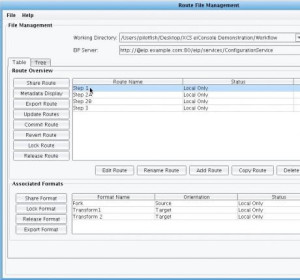XML Workflow
The eiConsole’s XML Workflow Component goes beyond Point-to-Point Integration and supports the Implementation of a wide variety of Workflow Patterns Common to More Complex BPM Applications.
The XML Workflow/BPM component, or Route module, of the Enterprise Integration Console (eiConsole) serves several purposes. Often times, automation of a business process requires more than simple point-to-point integration of Source and Target Systems. While the eiConsole provides a simple, assembly line approach to basic source-to-target interfaces – it also supports the implementation of a wide variety of the workflow patterns common to more complex business process modeling (BPM) scenarios.
The supported patterns include (but are not limited to):
- Sequencing
- Splitting
- Merging
- Branching
- Conditional Logic
- Iteration
The flexibility inherent in the eiConsole allows for different levels of modularity within an eiConsole interface. The most granular workflow node is a stage.
Stages are relatively atomic processes such as Listeners, Processors, Transformations, Routing or Transport. Each stage represents a single atomic action on data.
A Route, as shown below, represents a collection of these stages. These make up an XML Pipeline. In the eiConsole within a given Route, data travels in one direction between a set of Source Systems and one or more Target Systems.
Below, an example of a multi-route interface that demonstrates a number of the modules used in the implementation of a multi-stage XML workflow utilizing the eiConsole.

A single Route (shown below) with one Source (far left) and one Target (far right) is the most straightforward possible example of an XML workflow in the eiConsole. However, in the second example below – we have two defined Target Systems, one named PilotFish and one named Sharks (blue highlighted box, right).
![]()

When a Route has more than one Target, the Routing Module is used to select the appropriate execution path or paths. The eiConsole puts a number of different Routing Modules at your disposal. By far, the most common is the XPath and Attribute-based model. Click here to proceed to the XPath Routing Module.
For more information please call us at 860 632 9900 or click the link below to email us.

